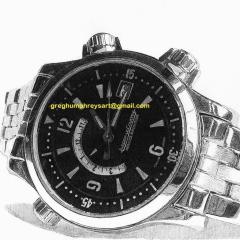-
Recently Browsing
- No registered users viewing this page.
-
Topics
-
Posts
-
By eccentric59 · Posted
The fact that the seconds runner starts running smoothly when you engage the chrono seconds makes me think the clutch is out of adjustment. That's a guess because I can't seem to find out too much about the chronograph module Breitling used on this model. On other Navitimers they used the Valjoux 7750 which had the running seconds on the left where the hand was mounted on an extended pivot on the fourth wheel. It looks to me that whatever pinion is driving that wheel is skipping teeth. Given that Breitling (et al) is not forthcoming with manuals or parts, I would send it back and ask for expedited service. They should be sufficiently embarrassed to do that for you at least. -
By HectorLooi · Posted
Looks like someone forced in a screw that was bigger than the hole. You would probably need to drill it out with a tungsten carbide rod sharpened at the tip to look like a spade drill. I'll see if I can find a video on how to make one. Start with a 0.5mm rod, then work your way up in 0.1mm increments until the walls of the hole weaken the screw enough to break it up. This is a very time consuming, slow process. You'll need to centre the hole properly and not deviate. WD40 helps. The other option is to abandon the hole and use a dial dot. As much as I hate dial dots, this might be the safest option for a beginner. Ok, found it. -
For those who are, curious I broke out the macro lens and took a few shots. I'm attaching four of them: Image 1 is from the watchmaker's side and generally shows the problem area. Image 2 is a detail view of the offending dial foot hole (called out with the green circle), the tip of the offending screw (orange arrow) and the blue line indicates the approximate position of what's left of the head of the screw (determined by using an oiler as a feeler gauge to transfer that measurement to the visible portion of the plate.) Image 3 is looking down the screw hole you can see the head of the broken screw at the bottom. Image 4 is the same, but with less contrast to give a better appreciation of the condition of that end of the screw. I can almost convince myself that I can see the remains of the screw slot in the head, but I have to use alot of imagination in that exercise. Heard and understood. There does appear to be a steel locating pin that can be seen in the lower, right center of Image 1 (right "above" the oval shaped slot that is to the left of where the pinion/clutch parts of the keyless works nestle into the plate.) As I don't see a way to remove that I'd have to keep it out of the solution and have even contemplated dropping a little paraffin on it to give it a "rain coat" of sorts. As I missed that before I did the closeup photos, I feel that I'm going to be looking at this plate in much greater detail to see if there anything else I might have missed. The screw assortments seem like a good acquisition. The eBay seller who has the donor movements I was looking at never replied so I may just take a chance and get one of those as well a screw assortment. They do seem like they'd be handy. I have to confess that the idea of fabricating the needed screws appears to some deep part of my soul, I also have to confess that I do not yet have either the equipment, or the skill to use it. Perhaps one day, but that day has not arrived (and I have alot of pricey bits and bobs that I will likely need to get along the way.) I thought about this, but the dial foot screw doesn't seem to be wide enough to get the thing out if I could advance it into the hole. I suppose that I could try and take it out in pieces (advance it as far as it will go, get in there with some sort of saw, take a piece off, walk it forward again, take another piece, etc) but that seems like alot of risk to the main plate. I need to examine the other screw to ensure it doesn't have a shoulder or something that would prevent me from doing something like that. However, all that said, I've been unable to get the thing to move at all. In general, this whole piece feels like someone had it before me, did a bad job of working on it and ultimately just bunged it all back together in a haphazard way and passed it on to be someone else's problem.








Recommended Posts